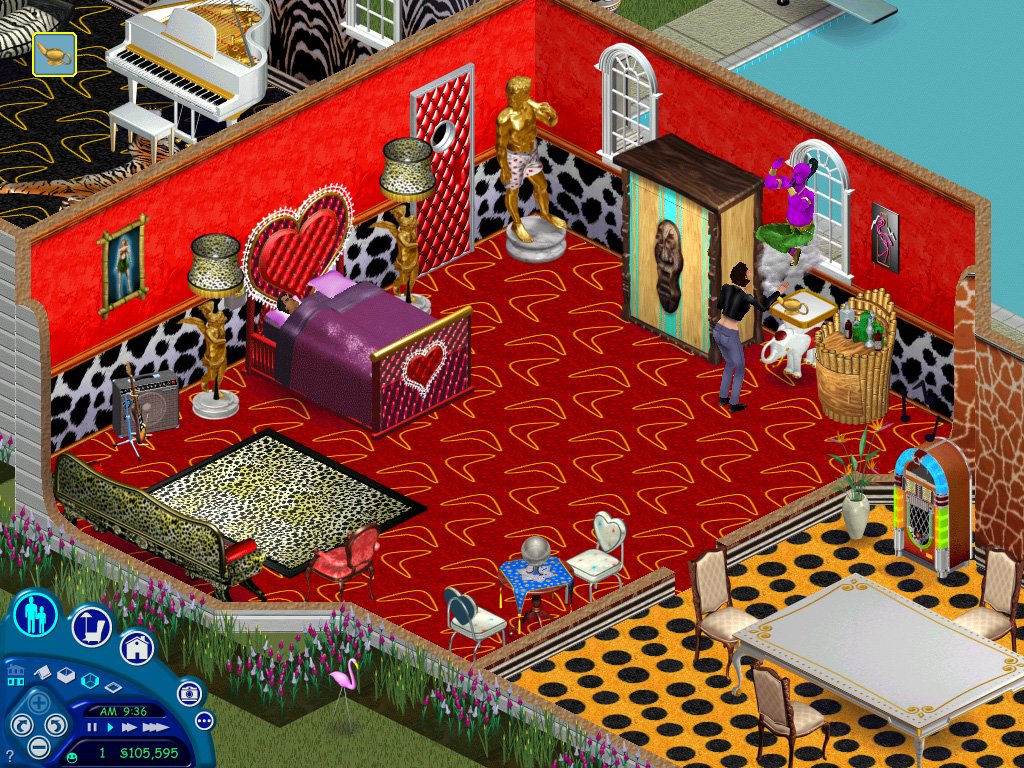The Sims (2000–) gives you the tools to build homes, invent characters, and orchestrate everyday lives – from breakfast to heartbreak. By turning relationships and routines into interactive systems, it reimagines the ordinary as playful design. It’s a space for self-expression, creativity, social exploration and community.
Like SimCity (1989), The Sims (2000) simulates life – but at the scale of individual lives and households. After losing his home in the 1991 Oakland–Berkeley firestorm, designer Will Wright began thinking about how people rebuild from scratch. The result was a game inspired by Maslow’s hierarchy of needs and built around everyday domestic life.
Wright called The Sims a “digital dollhouse”, where players could experiment with relationships, architecture and identity. There’s no winning or losing – only the opportunity to build, play and imagine. Each sequel has reflected changes in society, from career options and family structures to evolving cultural norms.
The Sims was also one of the first games to embrace queer relationships, with a same-sex kiss featured in the original trailer. Over time, players have helped push the game further, demanding greater representation and inclusivity. The result is a world where anyone can create – and recreate – their own version of home.
Curator notes
The animation pipeline
In The Sims, animators start by recording themselves performing actions – from gestures to full-body movements. These are recreated in 3D animation software, then refined and imported into the game. Voice is added after animation, with real-time tech syncing mouth movements to pitch and tone. This process allows one animation to support many lines, creating flexible performances that work across characters and contexts. It’s the opposite to traditional feature film animation, which begins with dialogue and then animation.
Create-A-Sim
The Create-A-Sim tool in The Sims 4 (2014) lets players build characters that reflect who they are. It includes over a thousand skin tones, a wide range of body shapes, hairstyles and features like top surgery scars and hearing aids.
Options that were once tied to gender – like voice pitch or how a Sim uses the toilet – are now available to everyone. Players can also choose custom pronouns, holidays, food and clothing to reflect different cultures.
Modding your Sims
It’s hard to get lost in a digital dollhouse when none of the dolls look like you.
The first Sims (2000) game included only three skin tones. The Sims 2 (2004) added one more. But even as diversity expanded, many Black players pointed out that darker tones appeared ashy and poorly rendered. Makeup options weren’t built for melanin-rich skin, often looking flat or cartoonish.
When The Sims 4: Vampires expansion launched, Simmer Amira Virgil noticed the “monstrous” skin tones resembled those of Black Sims. In response, she created the Melanin Pack (2016), a free custom content pack featuring 18 skin tones, undertones and melanin-friendly makeup. It gave players the tools to represent the richness and vibrancy of brown skin.
The Black Simmer community pushed for better in-game representation. EA listened. Collaborating with custom-content creator and artist Ebonix and Dark & Lovely, they added new skin textures and culturally specific hairstyles – affirming that every player deserves to feel seen.

Related works
Content notification
Our collection comprises over 40,000 moving image works, acquired and catalogued between the 1940s and early 2000s. As a result, some items may reflect outdated, offensive and possibly harmful views and opinions. ACMI is working to identify and redress such usages.
Learn more about our collection and our collection policy here. If you come across harmful content on our website that you would like to report, let us know.

